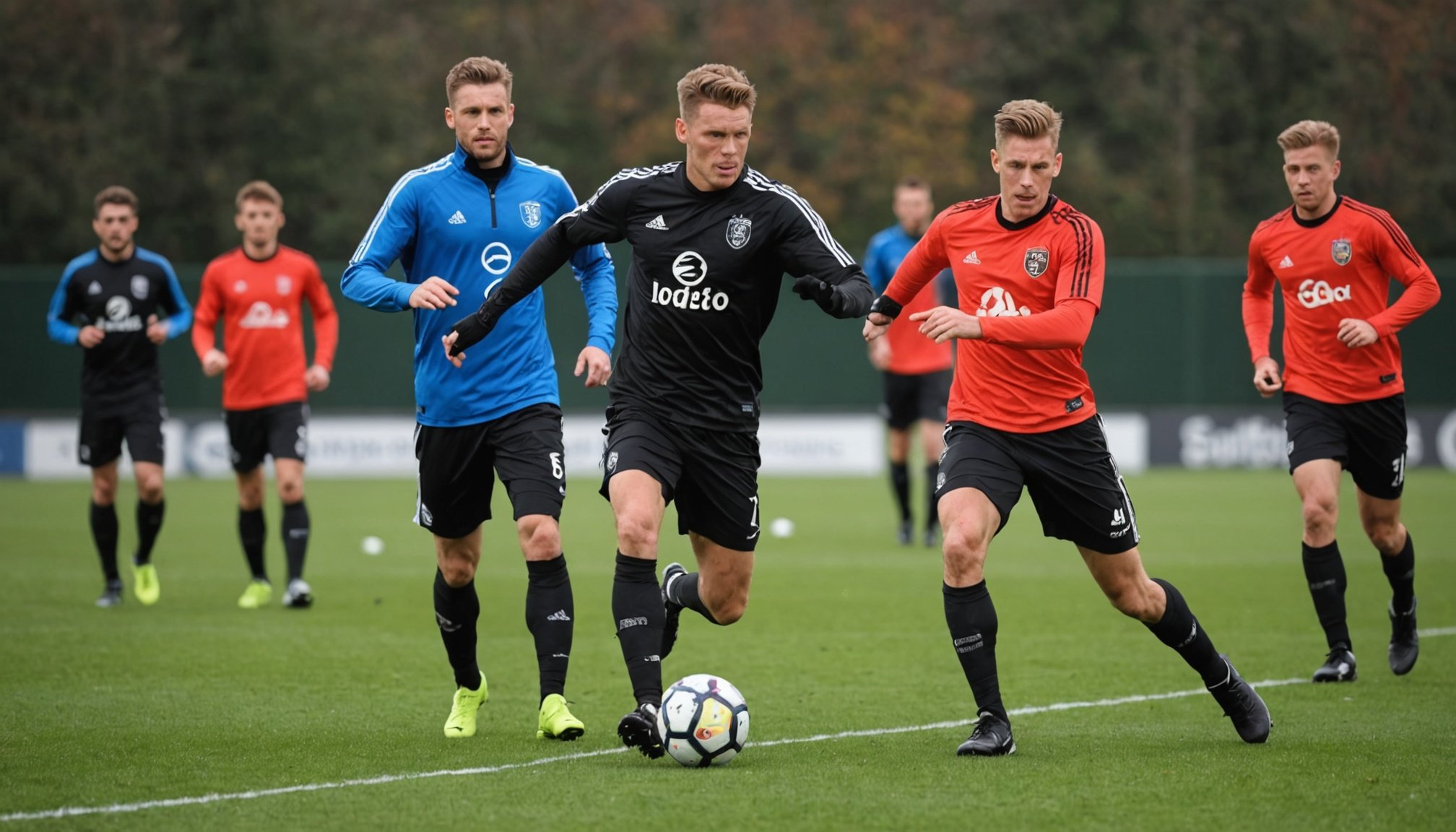Mastering Long-Range Passing in Football: Effective Training Techniques You Need to Know
Understanding the Importance of Long-Range Passing
In the dynamic and fast-paced world of football, the ability to execute long-range passes is a crucial skill that can significantly impact the outcome of a game. Long-range passing allows teams to quickly transition from defense to offense, catch opponents off guard, and create scoring opportunities that might not be available through short passes alone. Here, we will delve into the importance of long-range passing and provide detailed training techniques to help players and teams master this art.
Key Components of Effective Long-Range Passing
Technique and Ball Control
To master long-range passing, players must first develop a strong foundation in basic passing techniques. Here are some key components to focus on:
In parallel : Mastering Wet Weather: The Best Tactical Tweaks for Football Teams to Thrive in Rainy Conditions
-
Using the Inside Foot: For long passes, using the inside of the foot is often more accurate and controlled. This part of the foot provides a larger surface area, allowing for better contact with the ball and more precise direction[1][5].
-
Driven Passes: A driven pass involves striking the ball with more force to cover longer distances. Players should practice striking the ball with the laces (instep) for added power and accuracy[5].
This might interest you : Comprehensive player wellbeing blueprint: essential strategies for football clubs
-
Ball Control: Before making a long pass, it is essential to have good ball control. This involves being able to receive the ball under pressure and quickly orient it in the desired direction. Drills such as “Control Oriented” and “One-Touch Passes” can help improve this skill[2].
Strength and Accuracy
Long-range passes require both strength and accuracy. Here are some tips to improve these aspects:
-
Strength Training: Incorporating strength training into your regimen can help increase the power behind your passes. Focus on leg strength and core stability, as these are crucial for generating power when striking the ball[5].
-
Accuracy Drills: Practice passing from various distances and angles to improve accuracy. For example, set up targets in the corners of the goal and have players attempt to hit these targets from different positions around the penalty area[2].
Passing Drills to Improve Long-Range Passing
Short and Long Passing Drills
To improve long-range passing, it’s essential to practice both short and long passes. Here are some drills to help you achieve this:
-
Short Passes:
-
Triangle Passing: Set up a triangle formation with three players. Each player should be about 5-10 yards apart. Players pass the ball in a sequence, focusing on quick and accurate passes. Gradually increase the distance between players to simulate longer passes[1].
-
Long Passes:
-
Long Pass Drill: Divide players into pairs, with one player acting as the passer and the other as the receiver. The passer should be positioned at one end of the field, while the receiver moves into a designated area (e.g., the penalty box). The passer must deliver an accurate long pass to the receiver. Repeat this drill with varying distances and angles[2].
Moving Passing Drills
Passing while moving is a critical aspect of football, as it simulates real-game conditions.
-
Passing on the Move:
-
Dynamic Passing Drill: Set up a course where players must move while receiving and passing the ball. For example, have players run in a zigzag pattern while passing the ball to a teammate. This drill improves passing accuracy and decision-making under pressure[1].
-
Pressure Passing Drill:
-
Defender Pressure: Introduce a defender who pressures the player making the pass. This simulates game conditions where players must make passes quickly and accurately while under pressure. The player must control the ball in one touch and pass it to a teammate while moving[2].
Effective Communication and Decision Making
Effective long-range passing is not just about technique; it also involves good communication and decision-making.
Communication Drills
-
Verbal and Non-Verbal Communication:
-
Game Situation Drills: Practice game situations where players must communicate verbally and non-verbally. For example, have players shout or use gestures to indicate their intentions during passing drills. This enhances interaction and strengthens team cohesion[1].
-
Positioning and Movement:
-
Positioning Game: Set up a scenario where players must position themselves based on the ball’s location. This drill helps players understand where to move to receive long passes and how to create space for themselves and their teammates[2].
Decision Making
- Reading the Game:
- Small-Sided Games: Engage in small-sided games (e.g., 5v5) where players must make quick decisions about when to pass long or short. These games simulate match conditions and help players develop their game awareness and decision-making skills[2].
Physical Conditioning for Long-Range Passing
Physical conditioning is vital for executing long-range passes effectively.
Strength Training
- Leg Power and Core Stability: Focus on exercises that strengthen the legs and core. Squats, lunges, and deadlifts can help increase leg power, while planks and Russian twists can improve core stability[5].
Agility and Endurance
-
Agility Drills:
-
Ladder Drills: Use an agility ladder to improve foot speed and agility. Players can perform rapid foot movements through the ladder while dribbling a ball, enhancing their coordination and ball control in motion[2].
-
High-Intensity Interval Training (HIIT):
-
Sprint and Recovery: Incorporate HIIT sessions that involve sprinting followed by recovery periods. This type of training simulates the intense efforts required during a match and improves endurance and speed[2].
Practical Insights and Actionable Advice
Here are some practical tips and advice to help you master long-range passing:
Daily Practice
- Focused Drills: Dedicate time each day to practice specific passing drills. For example, spend 15-20 minutes practicing long passes with a teammate or by yourself using targets[5].
Team Training
- Integrated Training Sessions: Incorporate long-range passing drills into your team training sessions. This helps players develop teamwork and tactical understanding while practicing their passing skills in a competitive environment[5].
Mental Preparation
- Visualization Techniques: Use visualization techniques to mentally rehearse passing scenarios. Imagine yourself making perfect long passes and receiving them under pressure. This can boost your confidence and preparedness during actual games[5].
Table: Comparing Different Passing Drills
| Drill Name | Objective | Setup | Execution | Benefits |
|---|---|---|---|---|
| Triangle Passing | Improve short and long passing accuracy | Three players in a triangle formation | Players pass the ball in sequence, increasing distance gradually | Enhances passing accuracy and teamwork |
| Long Pass Drill | Practice long-range passing | Pairs of players, one passer and one receiver | Passer delivers accurate long passes to receiver in designated area | Improves long-range passing accuracy and strength |
| Dynamic Passing Drill | Practice passing while moving | Players run in zigzag pattern while passing | Players pass the ball while moving, simulating game conditions | Enhances passing accuracy and decision-making under pressure |
| Pressure Passing Drill | Practice passing under pressure | Defender pressures player making the pass | Player controls ball in one touch and passes to teammate while moving | Simulates game conditions, improving passing accuracy and decision-making |
| Small-Sided Games | Develop game awareness and decision-making | Small-sided games (e.g., 5v5) | Players make quick decisions about when to pass long or short | Simulates match conditions, enhancing game awareness and decision-making |
Quotes from Experts
-
“Effective passing facilitates smooth transitions and helps maintain possession. Aspiring stars should work on both short and long passes, ensuring they can execute accurately under pressure.” – [Source: How to Achieve Stardom in Football][5]
-
“Communication on the field is vital to coordinate movements and tactics. Players must develop verbal and non-verbal skills to make themselves understood during the game.” – [Source: Best Exercises for Soccer Players][1]
-
“The ability to stay focused, manage stress, and bounce back from setbacks is vital in any competitive sport. Mental toughness involves cultivating resilience.” – [Source: How to Achieve Stardom in Football][5]
Mastering long-range passing is a multifaceted skill that requires a combination of technical proficiency, physical conditioning, effective communication, and mental toughness. By incorporating the drills and techniques outlined above into your training regimen, you can significantly improve your passing accuracy and become a more effective player on the field. Remember, consistent practice and a well-rounded approach to training are key to mastering the art of long-range passing in football.






